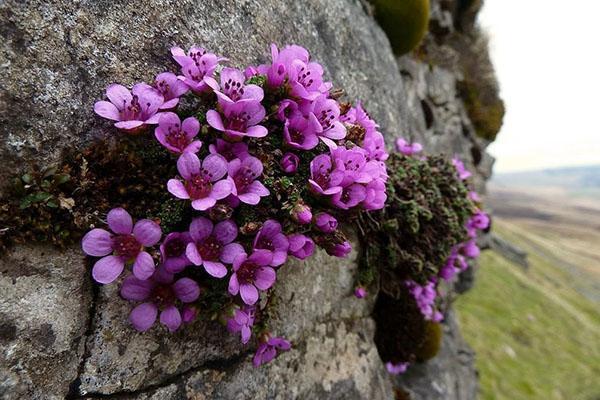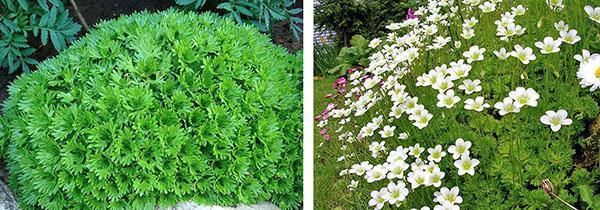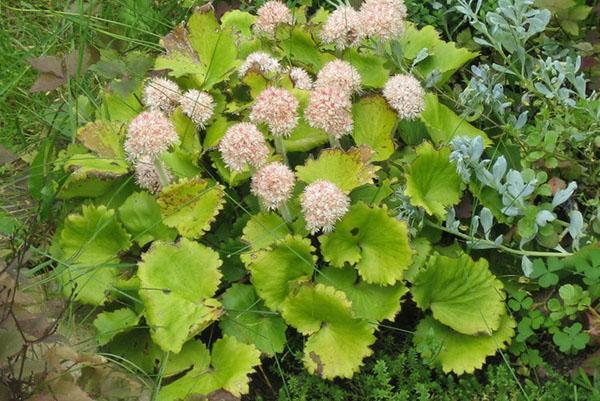Species and varieties of saxifraga
 Saxifrage is a fairly common perennial herb that many landscape designers love. The types and varieties of saxifrage are diverse. There are about 450 of them. The name of the plant speaks for itself. Saxifrage in nature is more common in the northern part of the globe and can grow even in extreme conditions: between stones, in crevices of rocks.
Saxifrage is a fairly common perennial herb that many landscape designers love. The types and varieties of saxifrage are diverse. There are about 450 of them. The name of the plant speaks for itself. Saxifrage in nature is more common in the northern part of the globe and can grow even in extreme conditions: between stones, in crevices of rocks.
general description

Most varieties are shade-loving, preferring to grow in moderately moist soil.
Saxifrage in nature is common in the northern regions. Most species are ground cover and vegetative parts of plants form a continuous carpet of leaves.
The appearance of plants depends on the species. Leaves can be dark green, gray in color. Rounded or elongated. Many varieties of saxifrage bloom for a long time. Flowers can be white, yellow, scarlet, pink.
Types and varieties of saxifrage
Saxifrage is used to decorate garden and park areas. Most often it is chosen for decoration. alpine slides, rock gardens or planted on rocky soils on the site. There are also varieties for indoor cultivation. Consider the most popular varieties of saxifrage.
Manchurian saxifrage
 The Manchurian saxifrage is a small plant with rounded leaves that retain their decorative effect during the entire growth period. It is distinguished by a large number of roots located almost on the soil surface. The flowering period begins in the second half of summer and lasts up to 45 days. The flowers are small, white-pink. The seeds ripen in the fall.
The Manchurian saxifrage is a small plant with rounded leaves that retain their decorative effect during the entire growth period. It is distinguished by a large number of roots located almost on the soil surface. The flowering period begins in the second half of summer and lasts up to 45 days. The flowers are small, white-pink. The seeds ripen in the fall.
Manchurian saxifrage prefers to grow on moist, loose soil. The species is frost-resistant, shade-tolerant, resistant to diseases and phyto-pests.
Saxifrage shadow
 The height of the shadow saxifrage is about 8 cm. There is a small fluff on the surface of the leaves. The plant forms small light pink flowers up to 15 cm high. During the growing season, it resembles a continuous carpet of leaves and towering peduncles.
The height of the shadow saxifrage is about 8 cm. There is a small fluff on the surface of the leaves. The plant forms small light pink flowers up to 15 cm high. During the growing season, it resembles a continuous carpet of leaves and towering peduncles.
View advantages:
- perfectly tolerates frosts even without shelter;
- disease resistant;
- not affected by pests;
- recovers quickly in case of mechanical damage;
- suitable for planting in shady areas;
- not afraid of sunburn.
Saxifrage shade grows well in soils with sufficient water. Even a short-term drought can affect the decorativeness of the plant.
Round-leaved saxifrage
 The round-leaved saxifrage is a plant up to 30-40 cm high. A distinctive feature of the species is its long flowering period - from the end of spring and throughout the summer. The flowers are white with red spots. The leaves are dark green, with jagged edges. The species can grow well both in the shade and in sunny places. Used for landscaping rocky areas. In plantings, it goes well with hosts, pelargonium, badans.
The round-leaved saxifrage is a plant up to 30-40 cm high. A distinctive feature of the species is its long flowering period - from the end of spring and throughout the summer. The flowers are white with red spots. The leaves are dark green, with jagged edges. The species can grow well both in the shade and in sunny places. Used for landscaping rocky areas. In plantings, it goes well with hosts, pelargonium, badans.
Positive aspects of the view:
- frost resistance;
- unpretentiousness;
- long flowering period;
- quick recovery from damage;
- resistance to diseases, pests.
Saxifrage paniculata
 Saxifrage paniculata forms peduncles up to 10 cm high. Blossoms in June with white-yellow flowers.Leaves are elongated, gray-green in color, jagged and calcareous protrusions along the edges. Foliage height 4-8 cm.
Saxifrage paniculata forms peduncles up to 10 cm high. Blossoms in June with white-yellow flowers.Leaves are elongated, gray-green in color, jagged and calcareous protrusions along the edges. Foliage height 4-8 cm.
To grow the species, you must choose a well-drained soil with a lot of calcium.
Advantages of the variety:
- the ability to winter without shelter;
- decorative leaves of an unusual shape;
- undemanding care.
Saxifrage paniculata is also called everliving or tenacious saxifrage.
Soddy saxifrage
 Sod saxifrage is rarely cultivated. Most often, this species can be found in its natural environment - in North America. The height of the plant during flowering does not exceed 20 cm. Flowers are white, red, pink. Opens in May-July. Flowering duration - up to 1 month.
Sod saxifrage is rarely cultivated. Most often, this species can be found in its natural environment - in North America. The height of the plant during flowering does not exceed 20 cm. Flowers are white, red, pink. Opens in May-July. Flowering duration - up to 1 month.
The appearance of saxifrage can vary depending on the place of growth. For planting, it is recommended to choose a shady area with light soil.
View advantages:
- suitable for growing in areas with little nutrients;
- can grow in open areas (it is necessary to shade from the sun).
Saxifrage juniper
 The name of the plant fully reflects the appearance of this species. Its leaves resemble needles juniper... The juniper saxifrage on the surface of the earth looks like a thorny dark green hummock. Blooms in May - June. At the same time, the peduncles reach a height of up to 15 cm. The flowers are yellow, spike-shaped.
The name of the plant fully reflects the appearance of this species. Its leaves resemble needles juniper... The juniper saxifrage on the surface of the earth looks like a thorny dark green hummock. Blooms in May - June. At the same time, the peduncles reach a height of up to 15 cm. The flowers are yellow, spike-shaped.
For planting, you must choose a loose, slightly alkaline soil. The species retains an unusual decorative appearance during the season.
Saxifrages propagate using seeds, dividing rosettes, cuttings.
Saxifrage opposite-leaved
 The opposite-leaved saxifrage differs from other species in relatively large - up to 2 cm, purple, pink flowers. The buds appear in early spring. The leaves are small, unattractive. In nature, it grows in tundra, forest-tundra, in the mountains. Red Book view of the Murmansk region.
The opposite-leaved saxifrage differs from other species in relatively large - up to 2 cm, purple, pink flowers. The buds appear in early spring. The leaves are small, unattractive. In nature, it grows in tundra, forest-tundra, in the mountains. Red Book view of the Murmansk region.
The opposite-leaved saxifrage is not suitable for planting in regions with hot climates.
View advantages:
- cold resistance;
- earlier flowering;
- the ability to grow both in the shade and in the sun;
- tallness - up to 60 cm;
- large colorful flowers.
Polar saxifrage
 The polar saxifrage is one of the few plants to show charming flowers during the short northern summer. The flowers are red. The leaves are fleshy. During the growing season, the plant forms a continuous cover of leaves and flowers.
The polar saxifrage is one of the few plants to show charming flowers during the short northern summer. The flowers are red. The leaves are fleshy. During the growing season, the plant forms a continuous cover of leaves and flowers.
Saxifrage Arens
 A hybrid variety that is widespread in the gardens of Russia. The leaves of the plant are elongated. The height of the rosettes depends on the variety - 10-20 cm.
A hybrid variety that is widespread in the gardens of Russia. The leaves of the plant are elongated. The height of the rosettes depends on the variety - 10-20 cm.
The flowers are large - up to 1 cm in diameter, they resemble bells. Painted in white, pink, scarlet, yellow. The saxifrage of rents, depending on the place of growth, can bloom from mid-spring to late summer for 1 month.
View advantages:
- hibernates without shelter;
- a plant in bloom up to 30 days;
- undemanding to care;
- decorative appearance.
The most common varieties of Arens saxifrage:
- Carmine red;

- Peter Pan;

- White carpet;

- Purplish pink;

- Floral carpet;

- Flamingo.

Saxifrage crested
 One of the few flowering medicinal plants of the tundra. Crested saxifrage is known for its high content of minerals and vitamins.
One of the few flowering medicinal plants of the tundra. Crested saxifrage is known for its high content of minerals and vitamins.
The leaves of the plant are elongated, small. The height of one saxifrage is from 3 to 15 cm. The flowers are white or white-yellow.
Saxifrage ascending
 A biennial native to Eurasia and North America. The stems of the plant can be from 5 to 25 cm. The leaves are relatively large. Serrated edges.
A biennial native to Eurasia and North America. The stems of the plant can be from 5 to 25 cm. The leaves are relatively large. Serrated edges.
The species has a long flowering period. The first snow-white flowers can be seen in early summer, the last - in August-September.
Ascendant saxifrage prefers to grow in well-humid areas.
View advantages:
- can be planted in areas with a lot of sunlight (shade at noon);
- seeds have fast germination;
- suitable for planting under tall trees and shrubs.
In some countries, the species is considered rare and is under state protection.
Escaping saxifrage
 This species is often planted as a houseplant. Found naturally in China, Japan. Prefers to grow in shaded areas. The plant got its name for its long shoots, which can reach up to 1 m in length.
This species is often planted as a houseplant. Found naturally in China, Japan. Prefers to grow in shaded areas. The plant got its name for its long shoots, which can reach up to 1 m in length.
The height of the saxifrage is escaping 10-15 cm. The leaves are large - up to 7 cm, rounded, densely pubescent. There are jagged edges on the edges. White veins may be visible depending on the variety. Flowers are small. Painted pink. Flowering occurs in late spring - early autumn.
Florists often plant it for colorful foliage, rather than for flowers, since they are not particularly decorative.
There are 2 more plant names:
- wicker saxifrage;
- offspring saxifrage.
Several varieties have been bred from this type of saxifrage: Tricolor, Harvest Moon and others.
Advantages of weaving saxifrage:
- large colorful leaves;
- winter hardiness;
- the ability to grow as an ampelous plant;
- undemanding care;
- the ability to maintain decorativeness even at low air humidity.
Saxifrage mossy
 A small plant up to 10 cm high. It has medicinal properties. The leaves are small, dark green, elongated. The surface of the leaves is rough. Peduncles are short - up to 6 cm. Flowers are white, yellow with red spots.
A small plant up to 10 cm high. It has medicinal properties. The leaves are small, dark green, elongated. The surface of the leaves is rough. Peduncles are short - up to 6 cm. Flowers are white, yellow with red spots.
Several varieties were obtained from the mossy saxifrage: Red Admiral, Elf, Fairy, Sprite and others.
View advantages:
- the plant is used in folk medicine;
- resistant to cold weather;
- the first flowers appear in spring;
- retains decorativeness throughout the growing season;
- can grow in poor soils;
- suitable for growing in places with a lot of sunlight.
There are many varieties of saxifrage in nature. The abundance of species and varieties, the cold resistance of plants allows them to grow in difficult natural conditions. Thanks to such unpretentious views, gardeners have the opportunity to decorate even stony, shady areas in the garden with colorful greenery.